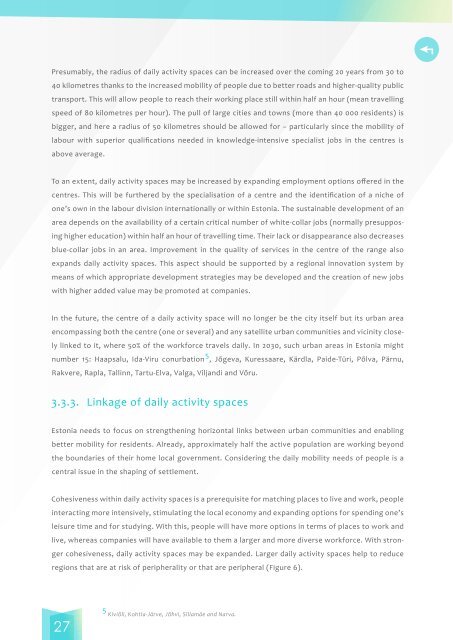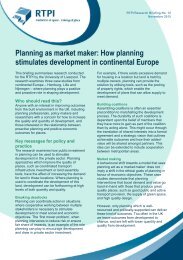estonia-2030_en
estonia-2030_en
estonia-2030_en
You also want an ePaper? Increase the reach of your titles
YUMPU automatically turns print PDFs into web optimized ePapers that Google loves.
Presumably, the radius of daily activity spaces can be increased over the coming 20 years from 30 to40 kilometres thanks to the increased mobility of people due to better roads and higher-quality publictransport. This will allow people to reach their working place still within half an hour (mean travellingspeed of 80 kilometres per hour). The pull of large cities and towns (more than 40 000 resid<strong>en</strong>ts) isbigger, and here a radius of 50 kilometres should be allowed for – particularly since the mobility oflabour with superior qualifications needed in knowledge-int<strong>en</strong>sive specialist jobs in the c<strong>en</strong>tres isabove average.To an ext<strong>en</strong>t, daily activity spaces may be increased by expanding employm<strong>en</strong>t options offered in thec<strong>en</strong>tres. This will be furthered by the specialisation of a c<strong>en</strong>tre and the id<strong>en</strong>tification of a niche ofone’s own in the labour division internationally or within Estonia. The sustainable developm<strong>en</strong>t of anarea dep<strong>en</strong>ds on the availability of a certain critical number of white-collar jobs (normally presupposinghigher education) within half an hour of travelling time. Their lack or disappearance also decreasesblue-collar jobs in an area. Improvem<strong>en</strong>t in the quality of services in the c<strong>en</strong>tre of the range alsoexpands daily activity spaces. This aspect should be supported by a regional innovation system bymeans of which appropriate developm<strong>en</strong>t strategies may be developed and the creation of new jobswith higher added value may be promoted at companies.In the future, the c<strong>en</strong>tre of a daily activity space will no longer be the city itself but its urban area<strong>en</strong>compassing both the c<strong>en</strong>tre (one or several) and any satellite urban communities and vicinity closelylinked to it, where 50% of the workforce travels daily. In <strong>2030</strong>, such urban areas in Estonia mightnumber 15: Haapsalu, Ida-Viru conurbation 5 , Jõgeva, Kuressaare, Kärdla, Paide-Türi, Põlva, Pärnu,Rakvere, Rapla, Tallinn, Tartu-Elva, Valga, Viljandi and Võru.3.3.3. Linkage of daily activity spacesEstonia needs to focus on str<strong>en</strong>gth<strong>en</strong>ing horizontal links betwe<strong>en</strong> urban communities and <strong>en</strong>ablingbetter mobility for resid<strong>en</strong>ts. Already, approximately half the active population are working beyondthe boundaries of their home local governm<strong>en</strong>t. Considering the daily mobility needs of people is ac<strong>en</strong>tral issue in the shaping of settlem<strong>en</strong>t.Cohesiv<strong>en</strong>ess within daily activity spaces is a prerequisite for matching places to live and work, peopleinteracting more int<strong>en</strong>sively, stimulating the local economy and expanding options for sp<strong>en</strong>ding one’sleisure time and for studying. With this, people will have more options in terms of places to work andlive, whereas companies will have available to them a larger and more diverse workforce. With strongercohesiv<strong>en</strong>ess, daily activity spaces may be expanded. Larger daily activity spaces help to reduceregions that are at risk of peripherality or that are peripheral (Figure 6).275 Kiviõli, Kohtla-Järve, Jõhvi, Sillamäe and Narva.




